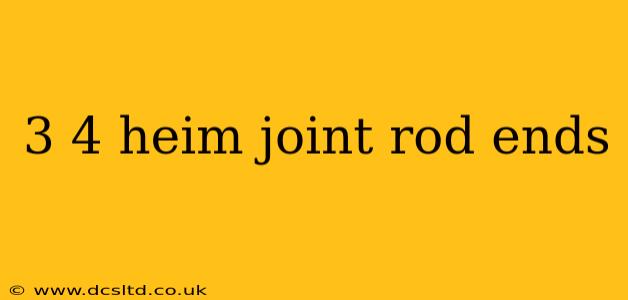Heim joint rod ends, also known as spherical bearings, are essential components in various mechanical systems requiring both articulation and load-bearing capacity. This guide dives deep into the specifics of 3/4 inch heim joint rod ends, exploring their applications, specifications, and selection considerations. We'll answer many common questions to provide a comprehensive understanding of this critical mechanical part.
What are 3/4 Inch Heim Joint Rod Ends?
3/4 inch heim joint rod ends are spherical bearings with a 3/4 inch diameter stud or shank. This dimension refers to the outer diameter of the rod end's threaded portion, which is used for connecting it to other components. The "heim joint" refers to the spherical bearing design that allows for angular movement and rotation, while maintaining a strong connection. They are typically made from high-strength materials like steel or stainless steel, providing durability and resistance to wear and tear.
What are the Different Types of 3/4 Inch Heim Joint Rod Ends?
Several variations exist within the 3/4 inch heim joint rod end category, distinguished primarily by:
-
Material: Steel, stainless steel, and even specialized alloys are employed, each offering unique properties regarding strength, corrosion resistance, and operating temperature ranges. Stainless steel, for example, is preferred in corrosive environments.
-
Thread Type: Different thread types (e.g., UNF, UNC, metric) are available to ensure compatibility with a wide range of applications and existing threaded components. Selecting the correct thread is critical for a secure and reliable connection.
-
End Fitting: The end fitting determines how the rod end connects to other parts of the system. Common types include male threads (stud ends), female threads (eye ends), and clevis pins. The choice depends on the specific application and overall system design.
-
Bearing Material: The internal bearing material can vary, impacting factors like friction, load capacity, and lifespan. Different materials offer advantages for specific applications—high-load situations might require a different bearing material than those subject to frequent articulation.
What are the Applications of 3/4 Inch Heim Joint Rod Ends?
The versatility of 3/4 inch heim joint rod ends makes them suitable for numerous applications, including:
-
Automotive: Suspension systems, steering linkages, and other moving parts often utilize these rod ends for their ability to handle both load and movement.
-
Industrial Machinery: Robotics, automation systems, and other industrial machinery benefit from their durability and precise articulation capabilities.
-
Agricultural Equipment: Components like linkage systems and hydraulic mechanisms frequently utilize heim joints.
-
Aerospace: Lightweight yet durable versions find applications in aircraft control systems and other areas requiring reliable articulation.
How Do I Choose the Right 3/4 Inch Heim Joint Rod End?
Selecting the appropriate 3/4 inch heim joint rod end hinges on several factors:
-
Load Capacity: The rod end must have a load capacity that exceeds the anticipated forces it will encounter.
-
Operating Angle: The maximum operating angle specifies the range of movement the joint can handle without compromising its integrity or performance.
-
Environmental Conditions: If the rod end will be exposed to harsh environments (e.g., corrosive chemicals, extreme temperatures), the appropriate material selection is crucial.
-
Thread Type and Size: Ensure compatibility with the mating threads on the connecting components.
What is the Difference Between a Heim Joint and a Spherical Bearing?
While often used interchangeably, "heim joint" is a specific type of spherical bearing. All heim joints are spherical bearings, but not all spherical bearings are heim joints. The term "heim joint" typically implies a specific design and manufacturing process, often emphasizing durability and strength under heavy loads.
Where Can I Find More Information on 3/4 Inch Heim Joint Rod Ends?
Consulting with a technical specialist or referring to the product documentation from reputable manufacturers will provide the most accurate and detailed information for specific applications and technical specifications.
Conclusion:
Understanding the nuances of 3/4 inch heim joint rod ends—their types, applications, and selection criteria—is vital for engineers and anyone working with mechanical systems requiring both articulation and load-bearing capabilities. By carefully considering the critical factors outlined above, you can ensure the selection of the correct rod end, promoting the safety, reliability, and longevity of your equipment.
